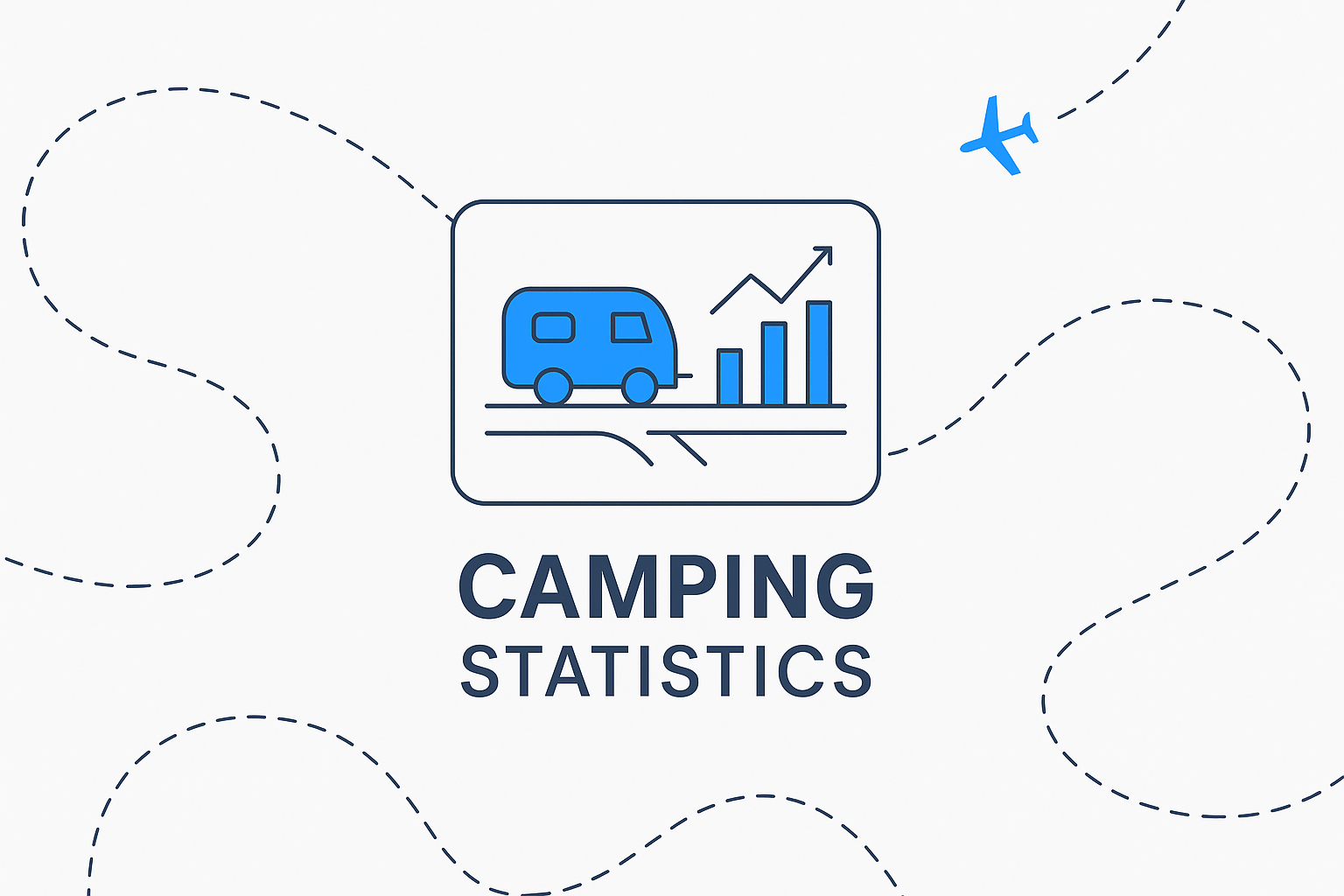Camping is bigger than ever — in 2022, over 92 million Americans went camping, and each year more than 50 million take trips into the outdoors.
What was once a niche outdoor hobby has rapidly evolved into a mainstream lifestyle embraced by millions of households worldwide.
From the surge in RV ownership to shifting generational habits, the numbers reveal a fascinating picture of how camping continues to grow and diversify.
What Are the Top Camping Statistics?
- Over 92 million Americans went camping in 2022, a record high.
- Each year, more than 50 million Americans take camping trips.
- At least 58 million U.S. households camp at least once annually.
- Millennials now make up 56% of all campers.
- About 40% of U.S. households participate in camping, and the number keeps rising.
- More than 70% of campers changed their habits in 2020 due to COVID-19.
- RV ownership has surged, with nearly 2.5 million new owners since the pandemic began.
How Fast Is Camping Growing?
- Participation in camping has expanded significantly, with 1 million new families starting to camp each year in the U.S.
- Since 2014, there have been over 7 million new camping households.
- Nearly 94 million North Americans now identify as campers.
- Active campers have increased by 68% in the last decade.
- In 2024, nearly 88 million people camped in North America.
Camping Participation Over Time
| Year | Campers / Households | Notes |
|---|---|---|
| 2019 | 91 million families | Continuous growth |
| 2020 | 48 million households | COVID-19 boom |
| 2021 | 93.8 million Americans | Record activity |
| 2022 | 92 million Americans | Highest on record |
| 2024 | 88 million in North America | Stabilization post-pandemic |
What Is the Economic Impact of Camping?
Camping is not only a leisure activity but also a major economic driver:
- The global camping equipment market was valued at $89.8 billion in 2024 and is expected to grow to $96.7 billion in 2025, with steady growth projected through 2032.
- The camping and caravanning market is projected to grow from $38.9 billion in 2025 to $64.8 billion in 2035.
- Americans spend hundreds of dollars per year on camping gear, RVs, fuel, and campsite fees, fueling steady growth in related industries.
Camping Market Value
| Segment | 2024 Value | 2025 Forecast | Long-term Outlook |
|---|---|---|---|
| Camping equipment | $89.8B | $96.7B | CAGR 8.6% to 2032 |
| Camping & caravanning | $38.9B | $40B+ | $64.8B by 2035 |
| Glamping | $3.4B | $3.8B | $9.3B by 2033 |
How Often Do People Go Camping?
- Americans typically go camping 1–3 times per year, averaging around 6.7 nights annually.
- A growing number of households now see camping as their primary vacation option rather than just an occasional trip.
How Popular Is RV Camping?
- In 2021, about 11 million RV owners took their vehicles camping.
- RV ownership rose by 12% nationwide in 2021.
- Nearly 2.5 million people invested in RVs during the pandemic.
- In North America, RV camping accounts for nearly 47% of all camping vehicles.
Despite the growth, many owners report using their RVs only a few times a year, suggesting untapped potential for the RV market.
Who Is Going Camping?
- Millennials account for 56% of campers, the largest single age group.
- Millennials and Gen Xers combined make up 70% of all campers.
- About 38% of U.S. campers are millennials.
- Among 1.4 million first-time campers last year, 51% were non-white, reflecting growing diversity.
- 77% of campers have some college education, and 60% earn over $75,000 annually.
Demographics of Campers
| Group | Share (%) |
|---|---|
| Millennials | 56% |
| Millennials + Gen X combined | 70% |
| New campers (non-white) | 51% |
| Campers with higher education | 77% |
| Campers earning >$75k | 60% |
How Is Sustainability Shaping Camping?
- Over 60% of campers now consider sustainability when planning their trips.
- The pandemic reshaped camping habits, with 70% of campers changing how they travel and camp.
- Interest in EV road trips is steadily rising.
- Many campers also prefer eco-friendly accommodations, which has fueled the rapid growth of glamping — a market valued at $3.4 billion in 2024, projected to reach as high as $9.3 billion by 2033.
Does Camping Improve Health and Well-being?
Camping is strongly associated with better physical and mental health:
- 93% of campers say camping provides benefits to their health and well-being (up from 85% in 2011).
- 44% of campers achieve a state of “flourishing” mental health, compared to just 31% of non-campers.
- 88% of campers report lower stress levels and better mood after trips.
- Nature exposure reduces anxiety, improves focus, and boosts overall happiness, according to medical research.
Health & Well-being Benefits
| Indicator | Campers | Non-campers |
|---|---|---|
| Report well-being benefits | 93% | – |
| “Flourishing” mental health | 44% | 31% |
| Lower stress after trips | 88% | – |
Where Is Camping Most Popular?
- Over 40 million Americans go camping each year, representing about 10% of the population.
- In 2020, more than 48 million U.S. households camped at least once.
- In 2019, the number of camping families in the U.S. reached 91 million.
- Outside the U.S., Australia is a leader in camping, with 15.3 million caravan and camping trips in 2023, generating AUD 14.3 billion in economic activity.
Frequently Asked Questions (FAQ)
How many Americans camp each year?
Over 92 million Americans went camping in 2022, and more than 50 million camp every year on average.
What percentage of campers are millennials?
Millennials make up about 56% of all campers, making them the largest camping demographic.
How many households own RVs?
There are about 11 million RV owners in the U.S., with ownership rising by 12% in 2021 alone.
Is camping becoming more diverse?
Yes, among first-time campers, over 51% were non-white, reflecting increasing diversity in outdoor recreation.
Are campers concerned about sustainability?
Absolutely — more than 60% of campers consider sustainability when planning their trips.
How big is the glamping market?
The glamping industry was worth about $3.4 billion in 2024 and is projected to reach between $5.5 and 9.3 billion by 2030–2033.
Does camping help mental health?
Yes — 93% of campers report benefits to their well-being, and 88% say camping reduces stress levels.
How many Americans camp each year?
Over 92 million Americans went camping in 2022, and more than 50 million camp every year on average.
How common is camping?
Camping is one of the most popular outdoor activities worldwide, with nearly 1 in 10 Americans going camping each year.
What percentage of campers are Millennials?
Millennials make up about 56% of all campers, making them the largest camping demographic.
Do Millennials like camping?
Yes, Millennials not only like camping but dominate participation rates, accounting for the majority of new campers.
Does Gen Z like camping?
Gen Z is showing rising interest in camping, particularly in glamping and sustainable camping experiences.
How many households own RVs?
There are about 11 million RV owners in the U.S., with ownership rising by 12% in 2021 alone.
Is camping popular in Europe?
Yes, camping is extremely popular in Europe, especially in countries like France, Germany, and the Netherlands, which have some of the largest camping markets in the world.
Is camping healthy?
Absolutely — camping promotes physical activity, fresh air, and mental well-being. 93% of campers report health benefits.
Is camping stressful?
Most campers find it stress-relieving rather than stressful — 88% report lower stress levels after camping trips.
Does camping make you happier?
Yes, research shows camping improves mood, reduces anxiety, and boosts overall happiness.
Why is camping so peaceful?
Because it removes you from daily distractions, connects you with nature, and reduces digital overload.
What is lazy camping?
Lazy camping refers to low-effort camping, often with pre-set tents, glamping pods, or minimal gear.
Which country is safest for camping?
Australia and Canada often rank as some of the safest countries for camping due to well-maintained sites and low crime.
What are the disadvantages of camping?
Potential downsides include exposure to weather, limited amenities, insects, and occasional safety risks in the wild.
What is the most forgotten item when camping?
Commonly forgotten items include toiletries, matches/lighters, or phone chargers.
How do people shower while camping?
Options include campground facilities, portable solar showers, or quick wash-ups in nearby rivers or lakes where permitted.
Conclusion
Camping is no longer just a summer getaway — it’s a thriving lifestyle that spans across age groups, income levels, and cultural backgrounds. The pandemic accelerated growth, driving millions of new households into the outdoors. Today, camping is more diverse, sustainable, and technologically integrated than ever before.
With over 92 million Americans camping annually, glamping on the rise, and RV ownership climbing at a rapid pace, the outdoor industry is poised for continued expansion. Whether you’re a millennial camper, a new RV owner, or simply curious about the outdoors, the numbers show one thing clearly: camping is here to stay.
Sources
- KOA — Camping & Outdoor Hospitality Report
- KOA — 2024 Camping & Outdoor Hospitality Report: Camper Profile
- RV Industry Association — 2025 Go RVing RV Owner Demographic Profile
- RV Industry Association — 2022 North American Camping Report Reveals Camping Accounts for 40% of Leisure Trips
- Fortune Business Insights — Camping Equipment Market Size, Share & Industry Analysis
- Grand View Research — Glamping Market Size, Share, Growth | Industry Report, 2030
- Future Market Insights — Camping & Caravanning Market Growth 2025–2035
- Research and Markets — US Glamping Market: Focused Insights 2024–2029
- IMARC Group — Glamping Market Size, Share, Growth Forecast, 2033
- Mayo Clinic — The Mental Health Benefits of Nature
- Sheffield Hallam University — New Study Shows Camping Is Good for Mental Health and Well‑being (Outjoyment Report)
- The Camping and Caravanning Club — The Outjoyment Report – Full Version (PDF)
- CamperChamp — Camping Statistics 2024 – USA & North America
- Tourism Research Australia — Caravan and Camping Data
- Caravan Industry Association of Australia — Who We Are (Industry Overview & Key Stats)



0 Comment